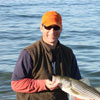How to Protect Spawning Fish in the Fall
By Tom Keer
Sep 07, 2016
Fall fishing can offer some of the hottest action of the year, but it’s spawning season for some fish species. Follow these these fall fishing tips to help you preserve spawning fish now, so you have more to catch next year.
In the spring I protect spawning fish by leaving them alone. That's my personal choice and it's based mostly on one point. If I catch that fish off the redd, I catch one fish. Others, like carp, can move in when the fish is off the redd and suck up all of the eggs. But if I leave momma fish alone until her eggs have hatched, then next year I'll have a lot more fish to catch. Short term pain, long term gain.
Most of the fish I target spawn in the spring, but there are a few different fish species that spawn in my area in the fall. So how do I handle catching these spawning fish? That's a tricky one, particularly since they are among the last fish I'll catch during the year.
Fishing Tips to Ensure Next Year’s Catch
1. Identify spawning fish species in your area. In mine, they are river fish: steelhead, Atlantic salmon, and brook trout.
2. Redd means stop. If I see a fish making or protecting a redd I don't disturb them. Instead, I move on to fish in other parts of the river or stream.
3. Focus time on pre-spawn. I try to catch these fish before they move into the spawning cycle. That way I reduce the loss of a hen's eggs in a fight.
4. Use as heavy a line or leader as possible. Heavier lines and leaders mean I can protect spawning fish by bringing them to the net as quickly as possible. Less lactic acid is built up in their bodies, recovery time is quicker, and there is less overall fatigue on the fish.
5. Use proper catch and release techniques. I keep the spawning fish in a net in the water, and hold them with cupped hands under the head and tail. I avoid putting pressure in their midsection so I don't force eggs to discharge.
6. Thoroughly revive fish. After catch and release, a fully-revived fish swims on to migrate upriver to spawn while improperly revived fish can go belly up.
7. Watch coloration for clues. Steelhead that just move into the rivers are bright and chrome colored. When they are in the rivers for a while they become more colorful. Brook trout near spawning time are brightly colored, too. So the more colorful they are the closer they are to spawning. I'll leave 'em alone around that time to protect spawning fish.
What happens next? I’ll make sure to have my fishing license up to date and if all things work out the way they should after following these fishing tips, I'll have a lot more fish to catch next year!
Most of the fish I target spawn in the spring, but there are a few different fish species that spawn in my area in the fall. So how do I handle catching these spawning fish? That's a tricky one, particularly since they are among the last fish I'll catch during the year.
Fishing Tips to Ensure Next Year’s Catch
1. Identify spawning fish species in your area. In mine, they are river fish: steelhead, Atlantic salmon, and brook trout.
2. Redd means stop. If I see a fish making or protecting a redd I don't disturb them. Instead, I move on to fish in other parts of the river or stream.
3. Focus time on pre-spawn. I try to catch these fish before they move into the spawning cycle. That way I reduce the loss of a hen's eggs in a fight.
4. Use as heavy a line or leader as possible. Heavier lines and leaders mean I can protect spawning fish by bringing them to the net as quickly as possible. Less lactic acid is built up in their bodies, recovery time is quicker, and there is less overall fatigue on the fish.
5. Use proper catch and release techniques. I keep the spawning fish in a net in the water, and hold them with cupped hands under the head and tail. I avoid putting pressure in their midsection so I don't force eggs to discharge.
6. Thoroughly revive fish. After catch and release, a fully-revived fish swims on to migrate upriver to spawn while improperly revived fish can go belly up.
7. Watch coloration for clues. Steelhead that just move into the rivers are bright and chrome colored. When they are in the rivers for a while they become more colorful. Brook trout near spawning time are brightly colored, too. So the more colorful they are the closer they are to spawning. I'll leave 'em alone around that time to protect spawning fish.
What happens next? I’ll make sure to have my fishing license up to date and if all things work out the way they should after following these fishing tips, I'll have a lot more fish to catch next year!
Popular Posts









